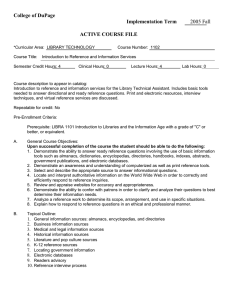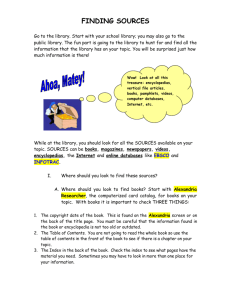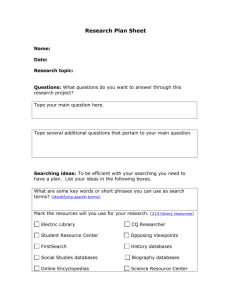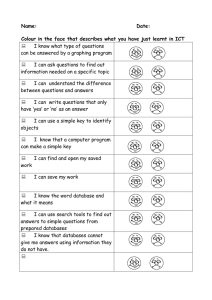Document 16048603
advertisement
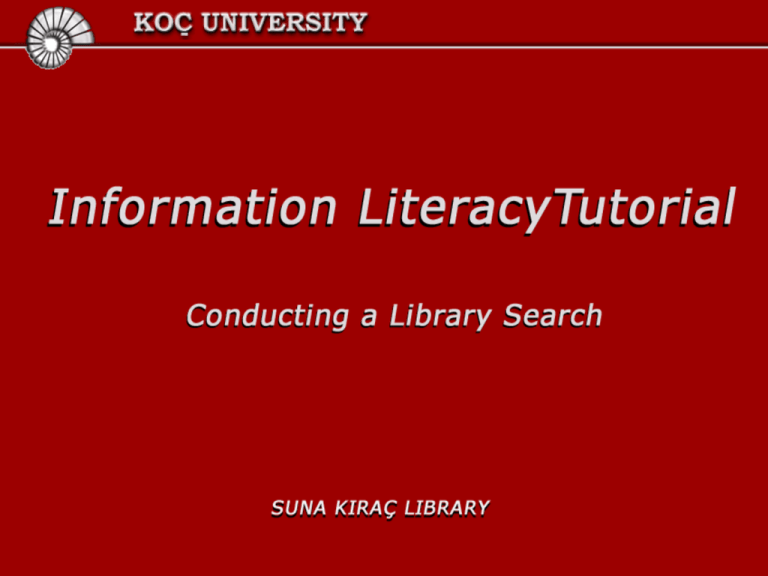
MAIN OBJECTIVE • The main objective of this tutorial is to teach you how to conduct a library search • Through this tutorial, you will gain basic information literacy skills This Tutorial covers: • HOW TO DO THE PRELIMINARY PREPARATION • HOW TO SELECT THE RIGHT ERESOURCE(S) • ADVANCED SEARCH TECHNIQUES • HOW TO EVALUATE THE SEARCH RESULTS • HOW TO CITE THE USED MATERIALS Preliminary Preparation means: • Choosing your topic • Defining your requirements • Finding background information • Refining your topic, if needed Choosing your topic • Sometimes choosing a topic is the biggest hurdle in doing research • Begin with: Remembering your course readings/class discussions Reviewing current periodicals Checking reference sources What are your information requirements? • Analyse your assignment to determine the type, quantity and format of information you will need • Try to answer the following questions: What kind of assignment do you have to complete? How much time do you have to complete your research? How much information do you need? What types of publications do you need? Finding Background Information • Before using e-resources, locate and read short articles that will give you a broad overview of the topic • These articles can be found in encyclopedias, dictionaries, almanacs, etc., which are also called reference sources Source: McGraw-Hill Encyclopedia of Sci. & Tech. General Encyclopedias & Dictionaries (1) • Encyclopedias are sets of books containing articles on various topics covering all branches of knowledge • Dictionaries are books giving information on particular subjects or on a particular class of words, names, or facts General Encyclopedias & Dictionaries (2) • They direct you to more specific sources • To locate them in the Library, do a subject heading search for “encyclopedias and dictionaries” in the Library catalog • Examples: Encyclopedia Americana, Encyclopedia Britannica General Encyclopedias & Dictionaries (3) To find them, go to the Library’s homepage and do a subject heading search for “encyclopedias and dictionaries” on the WebOPAC Subject-Specific Encyclopedias • Subject-specific encyclopedias provide detailed articles written by experts in the given field. They cover all aspects of one subject • To locate them, do a subject heading search in your area of interest • For instance, “Economics encyclopedias” retrieves 5 different encyclopedias in the catalog • Examples: Fortune Encyclopedia of Economics, Mc-Graw Hill Encyclopedia of Economics Almanacs • Almanacs are annual reference books of useful and interesting facts in different areas • To locate almanacs, do a subject heading search for “almanacs” and select the suitable one • From this search you can find 8 different almanacs • Examples: Wall Street Journal Almanac, World Almanac Where are These Sources Located in the Library? • General encyclopedias, dictionaries and almanacs are located in the Atrium on the ground floor • Subject-specific materials are distributed to different floors by subject (e.g Business Administration- 2nd floor). Please check the call number • If you encounter any problem, please consult the reference librarian responsible for the concerned collection HOW TO USE THESE SOURCES MOST EFFECTIVELY? • While reading the articles, take notes of distinct and unique words to be used as keywords in your query • For every source that you are interested in, write down the author, title and publication information • Locate the publications listed in the bibliography at the end of the articles Selecting keywords/search terms Topic: World War 2 Q: How did the World War 2 influence Japanese people? Kw: World War 2, Japan, Hiroshima Topic : Attack at WTC Q: What are the effects of the terrorist attack at WTC on the US economy? Kw: World Trade Center, September 11th, US economy Narrowing a Topic If your query retrieves too many hits: • Use AND & NOT as operators • Using AND between your search terms means that both terms must appear somewhere in the record • Example: AIDS and South Africa It retrieves sources containing information that pertains to AIDS in South Africa Broadening a Topic If your query retrieves very few or no hits: • Use OR as operator • OR enables you to enter other keywords that may also be used to describe your topic Example: AIDS or HIV or acquired immunodeficiency syndrome • Using OR between your search terms means that at least one of the terms must appear in the record Boolean Operators AND & NOT: Narrows a search, resulting in fewer hits Operator Example Search AND TV and Censorship items containing "TV" and "censorship" OR: OR TV or movies Broadens a search, resulting in more hits NOT TV not movies items containing either "TV" or "movies" or both items containing "TV" but not "movies" The search will find... Venn diagram How to Select the Right E-Resources • • • • • Selection of the right article database depends on: The subject area of your topic The types of sources needed Your level of knowledge of the topic Date of publication of the articles needed Format of the article (full text, full image, abstract, etc.) Subject Area of your Topic (1) • Which subject area is appropriate for your topic? Topic Focus Narrower focus Subject Area Database Drugs Drug abuse and genetic factors Gene & environment correlation Medicine Medline(Abstracts) Drugs Drug Education Peer pressure and drugs Psychology PsycInfo (Abstracts) Drugs Drugs and Employment Economic effects of addicted employees Business ABI/Inform(Proquest) (Full image&Abstracts) BSP(Ebscohost) (Full image&Abstracts) Subject Area of your Topic (2) • Once you have determined which subject area is appropriate for your topic, look at the list of 31 online databases available at http://www.library.ku.edu.tr/searchonline-database.shtml • The list has been organised alphabetically as well as by subject • Short descriptions and user manuals of these databases are provided by the vendors from databases’ websites Types of Sources Needed There are three types of databases: 1. 2. 3. General Interest / News Article Databases Discipline-Based Article Databases Subject-Specific Article Databases General Interest/News Article Databases They contain a mixture of popular magazines, daily newspapers and fewer scholarly journals Examples: Facts on File (EBSCOhost) (Information) Newspaper Source (EBSCOhost) (Full Image) Discipline-Based Article Databases They cover the subject fields within the disciplines of Science, Arts & Humanities or Social Sciences Examples: Institute of Physics Publications(IoPP) Business Source Premier (EBSCOhost) (Full Image & Abstracts) Subject-Specific Article Databases They cover a specific subject area and have highly scholarly coverage Examples: ERIC (Education and related disciplines) Engineering Village – 2 (Engineering) PsycINFO (Psychology and related disciplines) Dates of Publication of the Articles • Most online article databases began in the early 1980’s • If you are doing a retrospective/deep literature search, some of these databases will be of limited help • However, PsycINFO for example, has been indexing since 1887 • JSTOR provides complete backsets for covered journals from the first issue published until the last 3-5 years Level of Knowledge of the Topic If you are new to your topic: Look for articles in easy-to-understand language. Those found in general interest databases use common terms Articles in discipline-based databases usually have less jargon Articles in subject-specific databases assume that users have some background knowledge of the subject and often use special language Hints for Searching • If your search terms do not return enough hits, try using Boolean operators with other terms • Use complete and specific words for your search • Always check your spelling • Use synonyms in your search to find articles on the same subject using different terminology Advanced Search Techniques Adjacency Operators OPERATOR EXAMPLE WHAT IT FINDS WITHIN Education W/5 Internet One word must be within a specified number of words of another word. NOT WITHIN Mississippi NOT W/3 OF RIVER One word must NOT be within a specified number of words of another word. PRECEDED BY European PRE/2 Community One word must precede another word by a specified number of words WITHIN DOC Basketball W/DOC Michael Jordan Two Words must appear in the same article Combining Boolean Operators and Adjacency Operators Operators Example What It Finds OR and WITHIN Trend w/5 (Internet OR Web) Articles on Internet trends and web trends.Using OR will broaden the search, but using WITHIN limits the search AND NOT and WITHIN DOC Java AND NOT coffee W/DOC Sun Articles about Sun's Java technology, but not articles on growing coffee. Using AND NOT and using Within Doc both limit the search. OR and PRECEDED BY Military policy PRE/1 (U.S. OR American) Articles covering US military policy as well as articles referring to American military policy. AND and NOT WITHIN Herniated disc AND spinal cord NOT W/5 lumbar Articles about spinal cords AND herniated disks in the cervical and thoracic regions of the spine, but not the lumbar region. Truncation • Use the truncation character ? to find articles containing several words with the same root Example: Type educat? to find "educator“, "educators“, "educated“, "educating“, "education“, and "educational” Wildcard Character • Use the wildcard character * in the place of characters in your search terms, when more than one letter is likely to fit that space Example :Type educat** to find articles containing "educator" and "educated." Note: This search will not find "education", which follows "educat” with four letters rather than two Nesting Nesting enables you to combine several search statements into one search. Use parentheses to clarify the relationship between the combined search terms. E.g. Architecture and (Istanbul or Constantinople) combines “architecture” with either “Istanbul” or “Constantinople” Evaluation of the Search Results Criteria to consider when evaluating the search results are: • Quantity • Diversity (Variety) • Date of Publication • Quality and Reliability • Additional Resources Quantity & Diversity Quantity Enough resources are needed to: • Support your argument • Include a variety of viewpoints and materials Diversity Include many different resources • Primary Sources Contemporary accounts of an event and original documents Examples: letters, newspaper articles • Secondary Resources Retrospective sources based on primary resources; include scientific or scholarly analysis Examples: books, editorials Quality and Reliability Some factors to think about when assessing the quality and reliability of a publication are: • • • • • What is the tone? Who is the intended audience? What is the purpose of the publication? What assumptions does the author make? Does the content agree with what you know or have learned about the issue? Additional Resources Does the source provide other leads? Documentation (i.e. footnotes and bibliography) • • Provides additional resources Substantiates the author's research Evaluating Web Pages When evaluating web pages, check these issues: Authority (Who wrote/maintains the page?) Purpose/intended audience Currency of the data Objectivity vs. Bias Support Web Page Checklist (1) Authority • Look for the author’s name or a copyright credit () or link to an organization • Look for bibliographic information about the author • Look at the domain name(.comcommercial, .edu-education, .govgovernment, .org-organization etc) • (~) means a personal site (www.home.ku.edu.tr/~ayilmaz.html) • Look for contact information Web Page Checklist (2) Purpose / Intended Audience • What is the purpose of the page? • Who is the target audience? Currency • Is the information up-to-date? • To find whether the web page is up-to-date, one way is to click on ”View” then “Page Info” in Netscape for “Last modified” information • Is the author being objective or biased? Web Page Checklist (3) Support • Does the author support the information that s/he uses? • Is the support respectable? • If checking support is hard to make, be suspicious! Comparison of the Contemporary Materials You can also find what you are looking for in these contemporary materials: Scholarly Journals Substantial News General Interest Periodicals Popular Magazines Scholarly Journals • Articles in scholarly journals are written by scholars or researchers in the field, discipline or speciality • Purpose is to inform, report or make available original research • Published by professional organizations Examples: Harvard Business Review American Journal of Sociology Substantial News General Interest Periodicals • They are written for an educated, general audience either by the magazine’s staff, a scholar or free-lance writer • They provide general information to a wide, interested audience • Published by commercial enterprises for profit Examples: Fortune,Time Popular Magazines • Written by the publication’s staff or free-lance writers for a broad based audience • Designed to entertain or persuade people • Published for profit Examples: Reader’s Digest Sports Illustrated How to Cite the Used Materials? • Copying and paraphrasing statements from a source and using them without proper use of quotation and citation is plagiarism • Proper citation is important to avoid plagiarism and to give author’s credit for their work • There are two commonly used style formats, APA and MLA style formats APA Style • Established by the American Psychological Association • Preferred by most of the disciplines in the social sciences Example: Book by Two or More Authors Cone, J. D., & Foster, S. L. (1993). Dissertations and theses from start to finish: Psychology and related fields. Washington, DC: American Psychological Association. • To learn how to cite other types of sources, look at www.apastyle.org MLA Style • Established by the Modern Language Association • Preferred by most of the disciplines in the humanities Example: Book by Two or More Authors Cone, John D., and Sharon L. Foster. Dissertations and Theses from Start to Finish: Psychology and Related Fields. Washington, DC: American Psychological Association, 1993. • For other other types of sources look at www.mla.org Please feel free to consult Reference librarians at any stage of your research for further help. THANK YOU
